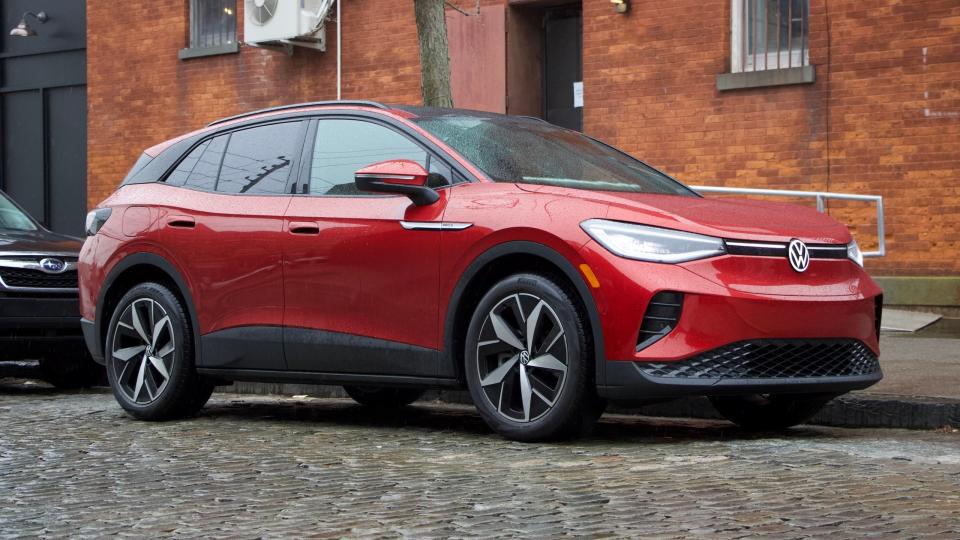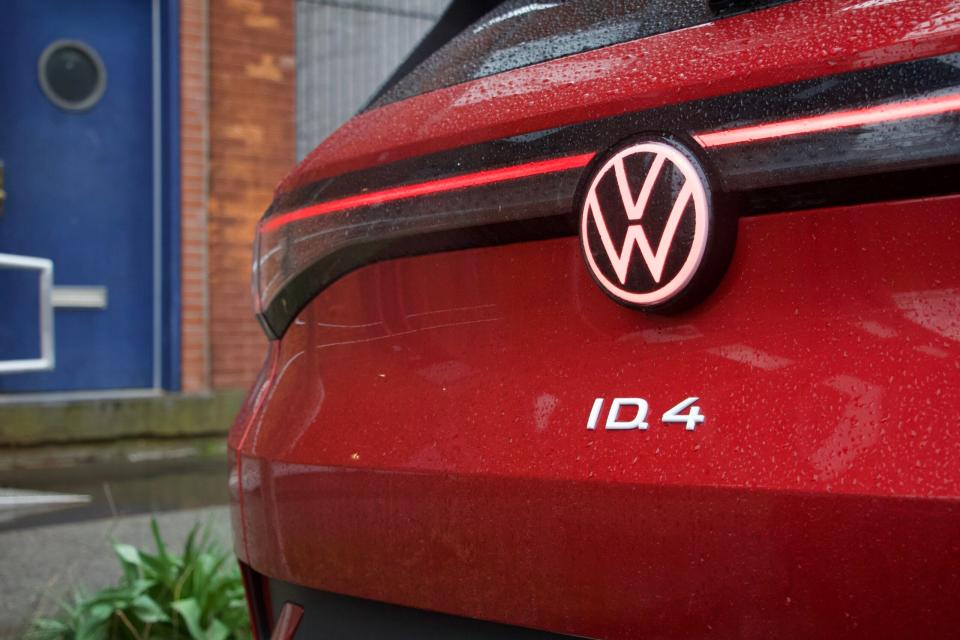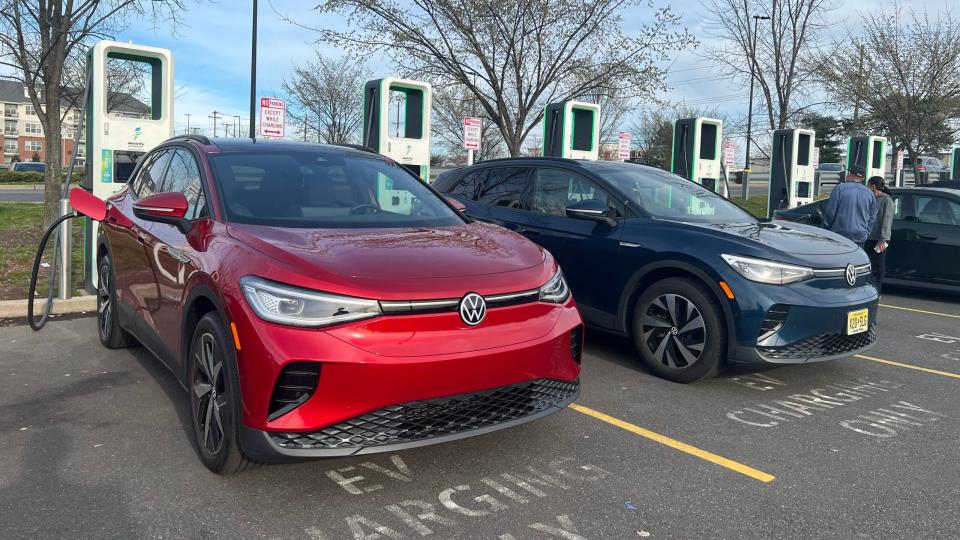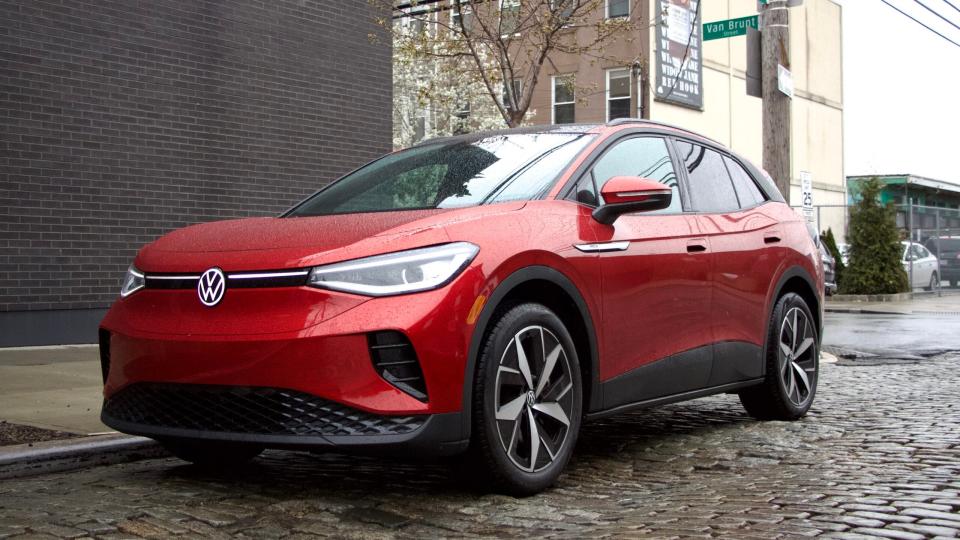2024 Volkswagen ID.4 Review: A Competent Daily That’s Still Kind of Annoying

The 2024 Volkswagen ID.4 has a column shifter. But it isn’t like most column shifters where you pull down for drive and push up for reverse. Instead, you twist away from you for drive, towards you for reverse, and push a small button on the end to engage park. It’s not bad per se, just different—but unfortunately, the ID.4’s controls and interfaces only get worse from there.
Take the driver’s window switches, for example. There are two, and a small capacitative touch panel marked “rear,” which you must first tap to operate the back windows. Then, there are the cruise control touch buttons on the steering wheel, which seemingly only adjust speed by 5 mph at a time and are easy to bump when trying for the annoying touch slider which controls audio volume. At least they’re backlit now.

If it sounds like I’m complaining about a lot of relatively minor things, I am. The ID.4 is, on the whole, competent, practical, and a pleasant place to spend time. But it’s also the friend who cuts corners, insisting he knows a faster way, and gets you lost in a dark alley late at night only to throw up his hands and proclaim, “I guess we’re lost.” Zach is a great guy, but we’re also really pissed at him right now.
The Basics
The ID.4 is VW’s midsize electric crossover. It’s aggressively mainstream in its approach, courting the sort of people who’d buy a Toyota RAV-4, Honda CR-V, or VW Tiguan but are ready to go electric. It’s currently the only EV in Volkswagen’s U.S. lineup, at least until they bring us that electric bus, already.
First introduced as a 2021 model, the ID.4 gets a mid-cycle update for 2024 with most of the goodies going to the 82-kWh “Pro” models. Those include a higher-performance electric motor, 12.9-inch touchscreen, ventilated front seats, and a Harmon/Kardon sound system, the latter only in the highest trims. All 2024 ID.4s regardless of battery size also come standard with VW’s IQ.Drive ADAS suite.



The upgraded drive units in the Pro models are good for a horsepower bump—a gain of 81 hp to 282 total in single-motor rear-wheel drive trim and 40 extra for a total of 335 hp in dual-motor all-wheel-drive form. The ID.4 also posts some small range gains for 2024: rear-drive models with the 82-kWh pack are now good for an EPA-estimated 291 miles, up from 275 last year, and AWD variants are rated at 263 miles, up from 255.
The base ID.4 starts at $41,160 including destination, and the Pro S I drove listed at $51,815. Notably, as of 2024, all ID.4s are eligible for the $7,500 federal EV tax credit as they comply with both manufacturing and battery sourcing requirements.
Driving the Volkswagen ID.4
The ID.4 drives pretty, well, normally, in keeping with its mission of courting first-time EV buyers. Its ride is smooth and compliant, it’s easy to see out of with large side-view mirrors. That clear visibility and a tight turning radius make parking easy, too.
I get the sense that VW deliberately toned down the EV driving experience to appeal to normies, too. Acceleration is brisk but the first inches of pedal travel feel dulled; you have to mash it to get that violent EV shove. The power is there, though, and it’s plenty for highway merges. You have to twist the shifter stalk forward twice for “B” to get proper regenerative braking, and even then it isn’t nearly as aggressive as the regen in a Polestar 2, for example. I didn’t find any setting or way to save a preference for regen braking—you have to take the extra couple of seconds to put the car in “B” every single time.





This gets old fast. I understand some first-time EV buyers may be uncomfortable with one-pedal driving, but making everyone else manually select it each time is ridiculous. At least give us the option.
Similarly, if you lift your foot off the brake in Drive, the ID.4 creeps forward at 2 or 3 mph like an automatic transmission gas car would, and unlike Tesla, I didn’t see a setting to turn it off. I get meeting your customers where they are, but taken with my gripe about regen braking, it feels like pandering.
Once above parking-lot speeds, most of my complaints disappeared. I drove the ID.4 from New York to Washington, D.C. to celebrate a friend’s birthday and found it a comfortable highway cruiser and a relaxing road-trip companion. The leatherette-trimmed seats were comfortable and supportive on four-hour journeys, and the ventilation function came in handy. There’s plenty of rear legroom, cupholder, and console space, and the sound system hits the right notes. Travel Assist, VW’s hands-on highway ADAS system proved competent, too.


Two minor road-trip gripes: As I mentioned above, the capacitative-touch buttons on the steering wheel are very easy to bump unintentionally. I accidentally bumped the cruise control down 5 mph multiple times while trying to adjust the volume, and vice versa. Several times, the car’s voice command system activated from general conversation and even music, blocking out sound and driving directions on the screen. I spoke to a fellow ID.4 driver at a charging stop who repeated this complaint unprompted.
The Highs and Lows
Roomy, comfortable, reasonably efficient, and easy to drive—these are all strengths of the ID.4. I think it’s handsome, too, especially in the Aurora Red of my tester. It’s a little blobby, sure, but not overstyled—and the light-up front end is a fun touch. I also enjoyed the visual battery gauge which stretches across the top of the dash when charging.
The negatives can be summed up in two words: user interfaces. There are many, and they’re not very good. Every HVAC adjustment is a touchscreen swipe or three. The capacitative buttons on the steering wheel are obtuse, and the lack of a permanently-selectable one-pedal drive mode is annoying. In trying for mass appeal, Volkswagen has instead managed mass annoyance.

I’d hoped the 2024 model would solve these issues, but unfortunately, it hasn’t. Volkswagen has already course-corrected, putting hard buttons back in the 2025 GTI hatchback, so there’s some hope they’ll get it right in a future model year.
Volkswagen ID.4 Features, Options, and Competition
The Volkswagen ID.4 starts at $41,160 including a $1,425 destination charge and tops out at $55,300 delivered for the top-trim Pro S AWD. That puts it squarely in competition with the Ford Mustang Mach-E, Tesla Model Y, and Hyundai Ioniq 5—not exactly lightweights in the EV crossover space. We can’t forget the Chevonda Prolazer, but the jury’s still out on the Ultium platform’s reliability.
The $5,140 jump between the base ID.4 and the Pro includes the larger battery and its 85-mile range gain, as well as the upgraded drive unit and its extra 81 hp. Another $5,120 separates S models from the Standard or Pro models of each battery size, bringing larger wheels, adaptive LED headlights, 12-way ventilated front seats, and more convenience features. The final $3,900 question is whether you want all-wheel drive or standard rear drive.

Ford, Tesla, and Hyundai’s longest-range variants all edge out the ID.4 by 12 to 29 miles on the EPA circuit—a sub-10% difference that earns them estimates that start with threes instead of twos. The VW’s tax credit advantage is a factor to consider, especially for those planning to purchase rather than lease.
Range, Charging, and Efficiency
The ID.4 offers a choice of two batteries: a 62-kWh base model, and the 82-kWh “Pro” I tested. The 62-kWh model gets 206 miles of EPA-estimated range with rear-wheel drive. With the larger battery, that figure climbs to 291 miles with rear-drive and 263 with all-wheel drive, respectively. Base cars can charge at up to 100 kW while Pro models allow 175-200 kW charging speeds.
In my experience, the RWD Pro S’ range estimates were pretty much bang-on. I left D.C. Sunday afternoon with 70% charge and 220 miles to empty. Due to a miscommunication with my passenger and a missed exit on the New Jersey Turnpike, we overshot our intended charging stop and had to press on another 40 miles, where we rolled in with 7% remaining. I don’t typically like to try my luck, but the car’s range estimate had been steady and accurate the entire trip, and it indicated 30 miles left after the 190-mile stint. After charging for 33 minutes at a peak speed of 137 kW, it was back at 80% and we hit the road for the home stretch.

As I’ve pointed out before, DC fast charging (the current, not the city) ain’t cheap. If you own an EV and mostly commute and make local trips, you’re much better off installing a Level 2 charger at home and plugging it in overnight. But if you’re road-tripping, it’s the only game in town. All in, I spent $59.42 for 103.6 kWh of juice to go about 500 miles. Even considering I picked the car up 86% charged and returned it at 62%, that’s impressive efficiency.
Value and Verdict
The 2024 Volkswagen ID.4 is a solid value in the current EV market, especially given its full qualification for the federal tax credit both when leased and purchased. Its combination of space, usability, and range make it a good fit for many families. But I’d struggle to recommend it wholeheartedly, based on the weaknesses of its user interfaces.
EVs are maturing and improving at such a pace that at just three years old, the ID.4’s age is starting to show. If it makes sense to daily one right now—and there are many reasons why it would—I’d recommend leasing instead of buying. Then again, that advice goes for most EVs in this market, and Hyundai’s excellent ones are among the cheapest to lease.
That leaves the ID.4 in a strange spot. Even with this latest update, its frustrating tech makes it feel a half-step behind in an ultra-competitive segment.
2024 Volkswagen ID.4 Specs | |
|---|---|


 Yahoo Autos
Yahoo Autos 